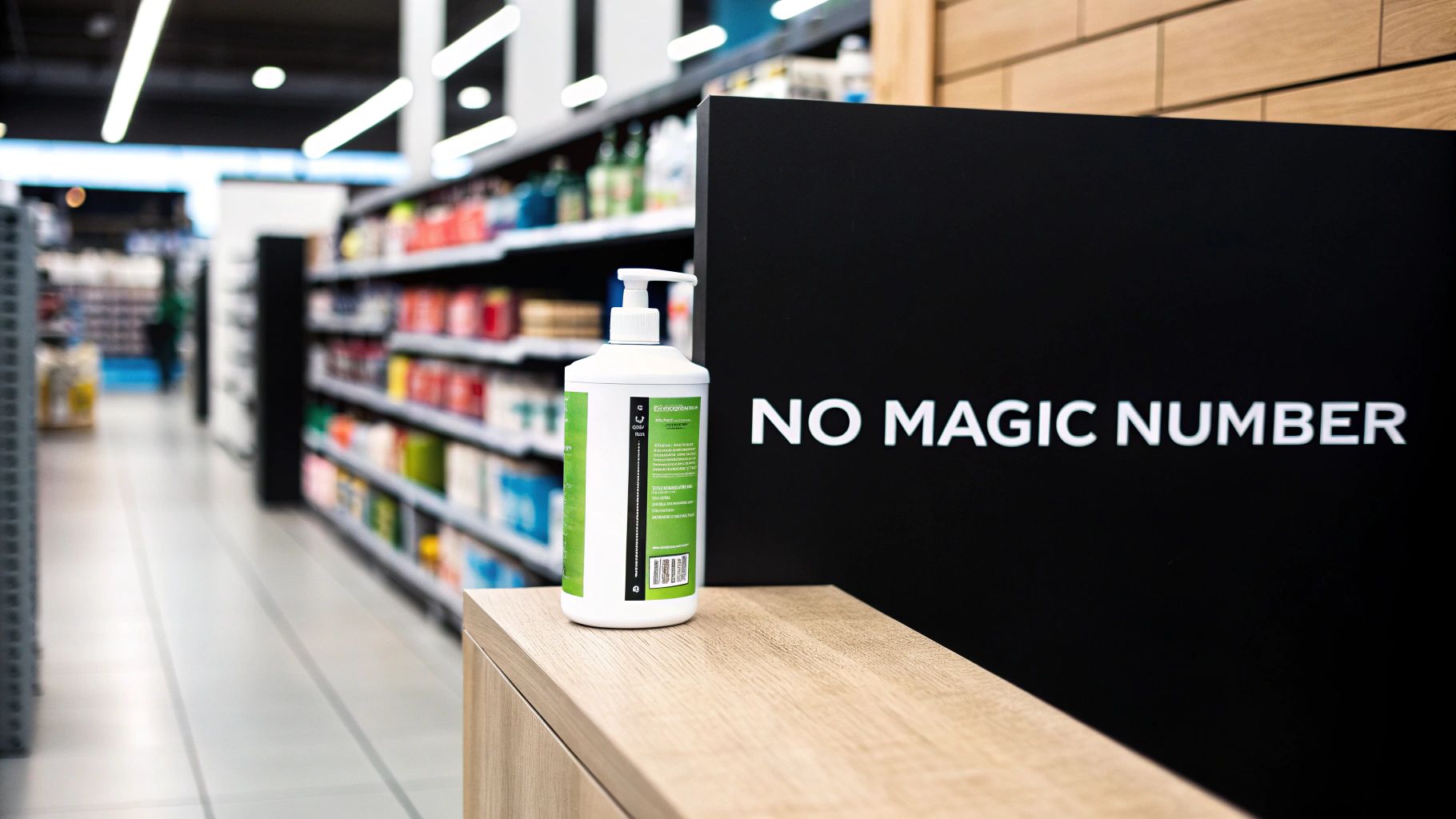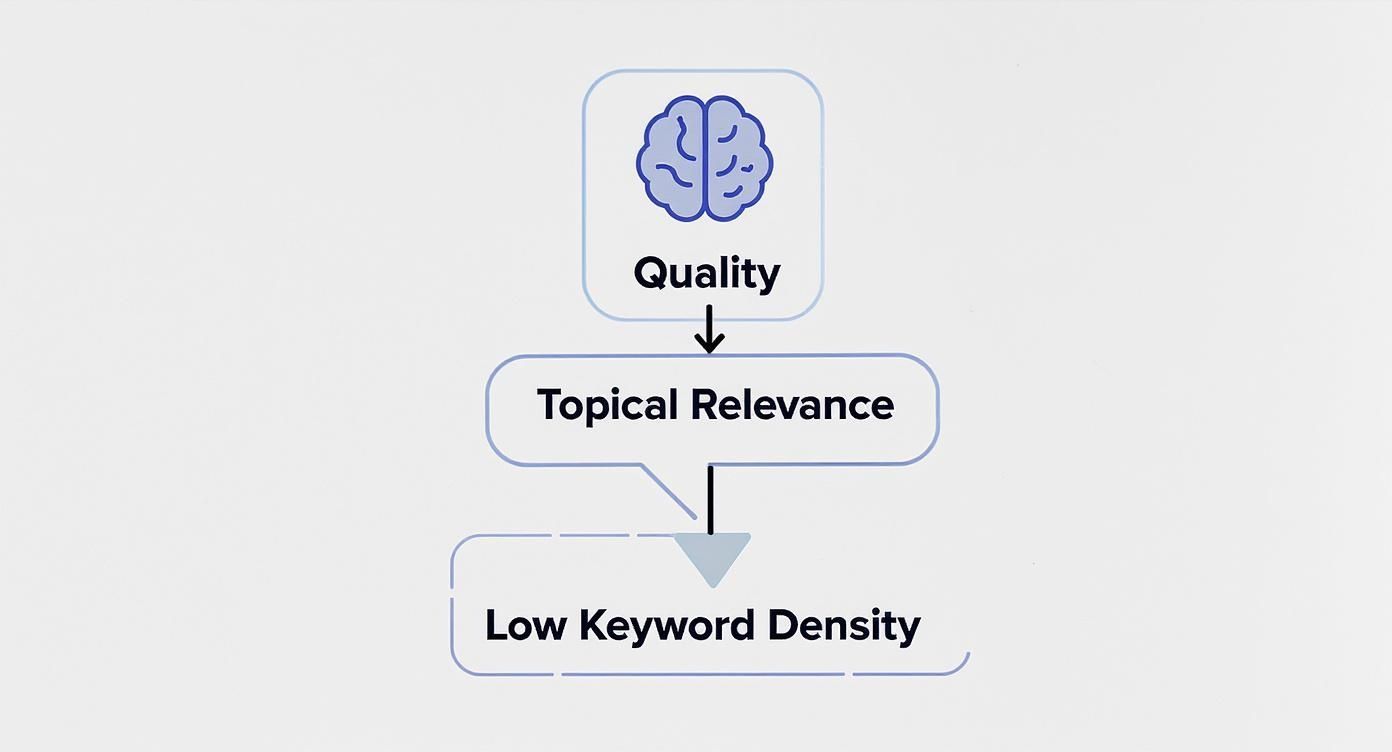
How Many Keywords for SEO Should You Actually Use?
Share
When people ask, "How many keywords should I use for SEO?" they're often looking for a magic number. The straightforward answer I always give is to focus on one primary keyword and maybe two to three secondary, related terms for any given page. This keeps your content sharp, relevant, and helps you steer clear of keyword stuffing, which went out of style years ago.
The Myth of a Magic Keyword Number

There's this persistent idea that if you just find the perfect number of keywords, your page will shoot to the top of Google. The truth is, modern SEO doesn't work that way. It's less about counting keywords and more about building topical authority and truly satisfying what the user is looking for.
Asking how many keywords to use is a bit like asking a chef how many spices to put in a soup. There’s no single answer! It completely depends on the recipe—the topic you're trying to cover.
A much better question to ask is, "How can I cover this topic so comprehensively that my page naturally starts ranking for a whole bunch of related searches?" The real goal is to create the single best resource for a specific subject, not to cram a dozen disconnected phrases onto one page.
Shifting Focus from Count to Cluster
Instead of getting hung up on a number, it's more effective to think in "keyword clusters." A cluster is just a group of keywords that are all related to one central topic. This is how search engines like Google actually understand content now—they look for context and depth, not just repetition.
Here’s how this strategy breaks down:
- A Primary Keyword: This is your North Star. It’s the main search term that defines the page's entire purpose (e.g., "commercial convection ovens").
- Secondary Keywords: These are close variations that add support and context (e.g., "restaurant convection oven," "best convection oven for bakery").
- Long-Tail Keywords: These are the super-specific, multi-word phrases that often come in the form of questions (e.g., "how to clean a commercial convection oven").
Chasing a magic number is an old, ineffective tactic. You’ll get much better results by focusing on building a genuinely helpful page, which is the whole idea behind mastering product page SEO without a keyword checklist. It’s a mindset shift from counting words to creating value.
For a quick reference, here’s a simple way to think about allocating keywords on any given page.
Quick Guide to Keyword Allocation Per Page
| Keyword Type | Quantity Per Page | Purpose |
|---|---|---|
| Primary Keyword | 1 | Defines the page's core topic and is the main ranking target. |
| Secondary Keywords | 2-3 | Adds context, captures related searches, and supports the primary term. |
| Long-Tail Keywords | 1-2 | Answers specific user questions and targets highly-qualified traffic. |
This table isn't a rigid rule, but it's a solid framework. It helps you keep the content focused while still covering the topic from multiple angles, which is exactly what search engines want to see.
The sweet spot for keywords on a single page usually hovers around 1-4 terms built around a single topic. This means one main keyword supported by a few closely related variations. It's a proven method for creating content that's both user-friendly and SEO-effective.
Why Quality Beats Quantity in Modern SEO
The old days of SEO felt like a numbers game, didn't they? We used to obsess over something called keyword density—basically, the percentage of times a specific term showed up on a page. The common belief was that more was always better.
Thankfully, that strategy is dead. Today, it’s a fast track to getting your site ignored by Google.
Search engine algorithms have gotten incredibly sophisticated. They no longer just count keywords; they understand context, intent, and the relationship between different ideas. This is the big shift from simply matching words to establishing topical relevance. Think of it this way: if you're talking to a friend, you wouldn't repeat the exact same phrase over and over. It would sound unnatural and forced. The same goes for your website content.
A page that ranks well today is one that covers a subject from all angles, naturally weaving in synonyms, related concepts, and answers to common follow-up questions. It's about creating a truly helpful resource for the user, not just a page optimized for a robot.
The Death of Keyword Stuffing
Forcing your main keyword into your text as many times as possible is a practice known as keyword stuffing, and it will actively hurt your rankings. Search engines are smart enough to see this for what it is: a cheap trick that creates a terrible reading experience.
The data backs this up. Top-ranking pages today have about 50% lower keyword density than they did just a few years ago. This isn't a coincidence; it’s a clear signal that Google rewards content that flows naturally. For more on this, check out the analysis from Hennessey Digital.
Your goal shouldn't be to win a keyword-counting contest. It should be to provide the absolute best answer to a person's question.
When you create a high-quality, authoritative piece of content, you'll find it naturally starts ranking for dozens of related search terms—not just the one you started with. That's where the real power is. For practical tips on creating content that both users and search engines will love, this guide on writing SEO friendly blog posts to rank higher is a great place to start.
How to Map Keywords to Your Website Structure
A great keyword strategy is about more than just finding the right terms; it's about smart placement. Think of your website like a real brick-and-mortar store. You wouldn't just dump all your products in a heap by the entrance, right? Of course not. You’d organize them into logical aisles and sections so customers can easily find what they’re looking for. Keyword mapping is just that—organizing your digital storefront.
The guiding principle here is simple: one page, one core topic. Every single page on your site needs a distinct purpose, targeting a tight-knit group of related keywords. This practice helps you sidestep a common pitfall called "keyword cannibalization," which happens when your own pages compete against each other for the same search term. That just ends up confusing Google and your visitors.
This infographic really drives home how modern SEO is all about quality and relevance, not just stuffing in as many keywords as possible.

As you can see, top-notch content and topical authority are the bedrock of a solid strategy. Low keyword density isn't the main event; it's a supporting player.
Assigning Keywords by Page Type
To build a site structure that actually works, you have to match the user's search intent with the right kind of page on your site. It’s all about meeting people where they are in their buying journey. This kind of thoughtful organization is a huge part of on-page optimization, which you can dive deeper into with our guide on what is on-page optimization.
Let’s look at a practical example for a restaurant equipment seller:
-
Homepage: This is your digital front door. It should target broad, high-level keywords that define who you are. Think terms like "restaurant supply store" or "commercial kitchen equipment." These phrases instantly tell visitors and search engines what your business is all about.
-
Category/Product Pages: Now we're getting specific. These pages are for transactional keywords—the terms people use when they're ready to buy. A page for refrigerators should aim for "commercial refrigerators" as its main keyword, with related terms like "reach-in coolers" or "undercounter freezers" playing a supporting role.
-
Blog Posts: Here’s where you answer questions and solve problems. Blog content is perfect for informational, long-tail keywords. A post titled "how to choose a commercial deep fryer" or an article on "restaurant kitchen design ideas" will attract potential customers who are in the research phase, establishing your expertise and building trust.
By giving every keyword a specific home, you create a site structure that’s both logical and powerful. You’re sending crystal-clear signals to search engines about what each page is for, which dramatically increases your chances of ranking for a whole host of relevant searches.
How to Outsmart the Big Guys with Long-Tail Keywords
It's easy to get fixated on those big, flashy, single-word keywords. But honestly? The real magic, and the real money, is often hidden in the longer, more specific phrases people type into Google when they’re actually ready to buy.
This is the world of long-tail keywords. These are search queries made up of three or more words, and they're your secret weapon.
Let’s go back to our restaurant equipment seller. Trying to rank for a super broad term like "ovens" is a recipe for frustration. You're going head-to-head with industry titans, and the search intent is all over the place. Is the searcher a home baker? A student writing a paper? It's impossible to know.
But what about a search for "double deck convection oven for small bakery"? Now we're talking. The search volume is lower, sure, but the person on the other end of that search knows exactly what they want. They aren't just browsing; they're on a mission. That makes them a red-hot lead.
Specificity Is Your Superpower
This is how you sidestep the Goliaths in your industry. Instead of fighting for broad terms, you attract visitors who are actively searching for the exact solutions you offer. You’re not just getting clicks; you’re getting the right kind of clicks.
And this isn't some tiny, niche tactic. It's how the vast majority of people actually search.
Believe it or not, long-tail keywords—those phrases with three or more words—account for a staggering 70% of all search traffic. That's a massive pool of potential customers that many businesses completely ignore.
Don't think long-tail means low-volume, either. Data reveals that over 29% of keywords with more than 10,000 monthly searches are made up of three or more words. You can find some more fascinating SEO statistics from Exploding Topics that back this up.
By focusing on long-tail keywords, you're directly answering the specific questions your best customers are asking. That's how you build trust and drive sales far more effectively than you ever could with a generic, high-volume keyword.
A Practical Keyword Strategy In Action

It’s one thing to talk about theory, but it’s another to see it work in the real world. Let's walk through how this all comes together for a restaurant equipment supplier. This is where the rubber meets the road—moving from a list of keywords to a living, breathing website strategy.
Think about a product page for commercial ice machines. This is your digital salesperson. Its sole job is to attract buyers who are ready to pull the trigger and to make that sale happen. The keywords here need to be sharp and focused on purchase intent.
Now, contrast that with the blog. Your blog is your educator, your friendly expert. It's there to catch people who are still in the "I have a question" phase. They aren't ready to buy, but they're hungry for good information. This is where you build authority and earn their trust long before they ever think about adding something to their cart. Our guide on how to write SEO-friendly blog posts breaks down exactly how to create that kind of valuable content.
Example Keyword Map for a Restaurant Equipment Website
So, how do you keep all this straight? You create a keyword map. It’s a simple blueprint that assigns specific keywords to specific pages, giving every piece of content a clear purpose. This prevents your pages from competing against each other and tells Google exactly what each page is about.
Here's a snapshot of what that looks like. You can see how different pages work together to attract customers at every stage of their journey.
| Page Type | Primary Keyword | Secondary Keywords | Long-Tail Keyword (Blog) |
|---|---|---|---|
| Product Page | commercial ice machine | undercounter ice maker, nugget ice machine for sale | How to choose the right size ice machine |
| Product Page | commercial range oven | 6 burner gas range, restaurant stove with oven | Gas vs electric commercial range comparison |
| Category Page | walk-in coolers | commercial walk-in freezer, outdoor walk-in cooler | Walk-in cooler installation checklist |
See how that works? The table transforms a jumble of keywords into an organized, actionable plan. Each row is a piece of your SEO puzzle, designed to attract a specific type of searcher. This kind of clarity is what separates a keyword strategy that just exists from one that actually drives results.
Common Questions About Keyword Targeting
Even with a great keyword strategy on paper, you're bound to run into some practical questions when you start putting it into action. Let's walk through a couple of the most common ones we hear from restaurant equipment sellers.
Getting these details right is what separates a plan that looks good from one that actually works.
Can I Target the Same Keyword on Multiple Pages?
This is a classic question, and the answer is a firm no. When you target the same primary keyword on more than one page, you create a problem called "keyword cannibalization."
Think of it this way: you’re essentially making your own pages compete against each other in Google's search results. This splits your authority, confuses search engines, and ultimately hurts your chances of ranking well for that term.
The fix is simple: stick to the "one page, one core topic" rule. Every page on your site should have its own unique primary keyword. This creates a clear roadmap for Google, showing it exactly which page is the best answer for a specific search.
How Often Should I Update My Keyword Targets?
Your keyword list shouldn't be carved in stone. The restaurant industry is always changing—new equipment trends pop up, and the way your customers search evolves. A good rule of thumb is to do a full review and refresh of your keyword strategy at least once or twice a year.
That said, you should be keeping an eye on your performance much more often. A huge piece of this is knowing how to track keyword rankings to spot what’s working and what isn’t. If you have a page that's been languishing for a few months with no traction, it might be time to rethink its keyword focus.
Don't be afraid to pivot. If a keyword isn't bringing in the right kind of traffic or is just too competitive, it's smarter to adjust your aim than to keep pushing a losing strategy. SEO is all about continuous improvement.
These regular check-ins ensure your website stays in sync with what your customers are actually looking for, keeping you relevant and competitive.
Ready to build a keyword strategy that brings in qualified buyers? Restaurant Equipment SEO can create a tailored plan that gets you noticed. See how we can help at https://restaurantequipmentseo.com.